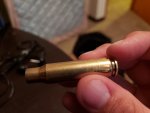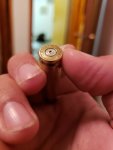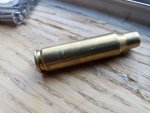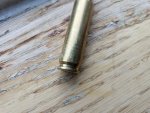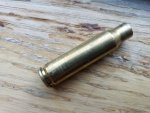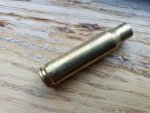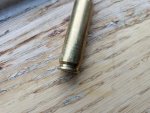Hey guys, was testing out my buddies rifle yesterday. He has a rem700 AAC sr or something, a 20" 308 rem700 with a threaded heavy contour barrel.
Testing some reloads we go from basically no pressure signs and reasonable bolt lift to a completely locked bolt. Required a solid amount of force to move the bolt up and a significant amount of force to get the bolt rearward to eject the case. Really no pressure signs on the case itself other than very slight cratering on the primer pocket with no ejector smear that I can see.
There appears to be some galling on the side of the case making me think there may be a bur inside of the chamber. I didn't notice the galling until I had gone back home and no longer had the rifle in my possession.
The fired case would not rechamber. I could place the case into the chamber with my fingers, push the bolt forward until the extractor engaged and would immediately get resistance in slide the bolt back without ever locking it down.
Is this in any way a head space issue? Unfired rounds feed very smoothly. And eject smoothly as long as they have not been fired. This is reloaded ammunition, FL resize, trimmed to 2.005", case thickness at the neck is .015", neck diameter is .335 without a bullet seated into it and .337 with a bullet seated into it. Fired case the neck OD measured to .346 I believe. I actually don't remember 100% on that measurement, but it was around .347-.344, and I can measure the OD of the fired case neck when I get home.
This is the first time I've shot my buddies rifle or tried my reloads in them. Used 43grns varget with a 178grn eldx, fired out if my rifle there were zero pressure signs at all. Nice round primer and no cratering. In his rifle, only slight cratering as seen in the picture. Unfortunately I do not have a headspace comparator yet. I have one on order from amazon so I can measure how much the shoulder moved after being fired compared to a freshly resized case.
My buddy has shot some lighter hunting factory ammo, hornady american whitetail ammo, both 150grn and 165grn factory ammo. All of those cases had cratered primers, but had never had problems with extraction or heavy bolt lift. I can't say with 100% certainty how loose the bolt lift was with those factory rounds as I was not there and my buddy is new to shooting and may have just assumed a heavy bolt lift was normal. However. When the bolt is getting jammed that obviously isnt supposed to happen.
Sorry for the long post guys but I am just looking for ideas of what it may be. I really don't think it is simply an overpressure load. I have run some stupid high overpressure loads in my rifles, to include a rem700, to the point I was popping primer pockets and have never had a bolt seized up this badly.
Testing some reloads we go from basically no pressure signs and reasonable bolt lift to a completely locked bolt. Required a solid amount of force to move the bolt up and a significant amount of force to get the bolt rearward to eject the case. Really no pressure signs on the case itself other than very slight cratering on the primer pocket with no ejector smear that I can see.
There appears to be some galling on the side of the case making me think there may be a bur inside of the chamber. I didn't notice the galling until I had gone back home and no longer had the rifle in my possession.
The fired case would not rechamber. I could place the case into the chamber with my fingers, push the bolt forward until the extractor engaged and would immediately get resistance in slide the bolt back without ever locking it down.
Is this in any way a head space issue? Unfired rounds feed very smoothly. And eject smoothly as long as they have not been fired. This is reloaded ammunition, FL resize, trimmed to 2.005", case thickness at the neck is .015", neck diameter is .335 without a bullet seated into it and .337 with a bullet seated into it. Fired case the neck OD measured to .346 I believe. I actually don't remember 100% on that measurement, but it was around .347-.344, and I can measure the OD of the fired case neck when I get home.
This is the first time I've shot my buddies rifle or tried my reloads in them. Used 43grns varget with a 178grn eldx, fired out if my rifle there were zero pressure signs at all. Nice round primer and no cratering. In his rifle, only slight cratering as seen in the picture. Unfortunately I do not have a headspace comparator yet. I have one on order from amazon so I can measure how much the shoulder moved after being fired compared to a freshly resized case.
My buddy has shot some lighter hunting factory ammo, hornady american whitetail ammo, both 150grn and 165grn factory ammo. All of those cases had cratered primers, but had never had problems with extraction or heavy bolt lift. I can't say with 100% certainty how loose the bolt lift was with those factory rounds as I was not there and my buddy is new to shooting and may have just assumed a heavy bolt lift was normal. However. When the bolt is getting jammed that obviously isnt supposed to happen.
Sorry for the long post guys but I am just looking for ideas of what it may be. I really don't think it is simply an overpressure load. I have run some stupid high overpressure loads in my rifles, to include a rem700, to the point I was popping primer pockets and have never had a bolt seized up this badly.

